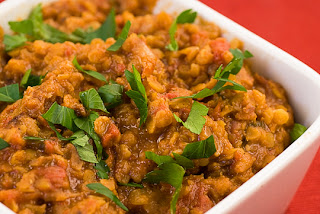If you want your Thanksgiving to be an absolute slam dunk this week, serve this. You could burn the turkey, forget the pies, and substitute sand and shaving cream for the green bean casserole, but as long as you make these tamales, people will rave about how good dinner was for the next five years. I'm serious about this.
You serve these
tamales with good ol’ fashioned gravy as the sauce. SO GOOD!
Note that the fruit (apples and cranberries) are optional here... In normal stuffing, I'd actually think the the addition of fruit would be an abomination. But for some reason with these tamales, they add a wonderful bright touch when you factor in the masa and smothering of gravy. So if you want to be a tad adventurous, definitely keep the apples and cranberries in (you can even double the cranberry quotient or experiment with date pieces or dried mango bits in place of cranberries if you want!). But if you are a staunch traditionalist with your stuffing flavor profile, you'll be just fine omitting the sweet stuff.
If you prefer, you can omit the fruit and opt for vegan sausage. Beyond spicy Italian is my preferred sausage. Just cook it as the instructions specify and crumble coarsely after it has cooled. If you do that, add the sausage right before you mix the stuffing together with your hands.
Prep time: 4 cocktails (but can be made weeks ahead of time and frozen)
1 package dried corn husks
1 cup (2 sticks) unsalted butter (don’t use margarine or
oil)
1 bunch celery, leaves included, chopped finely
2 large onions, chopped
6 cloves garlic, minced
3 TBSP fresh sage, minced
1 teaspoon dried thyme
1 tsp salt
1 tsp freshly ground pepper
1 pound mushrooms, chopped
1 apple, peeled, cored and finely chopped
1/2 cup dried cranberries (or golden raisins)
1 cup pine nuts, toasted
8 cups day-old bread, (about 12 slices), cut into ½-inch
squares and toasted
2 cups veggie stock
Gravy for serving
Start by soaking the corn husks in a big bowl. Submerge them in hot water and
let them soak for at least a half hour. You’ll want at least 50 husks. You’ll
also need something heavy to set on top of the husks so they remain submerged.
I use a brick.
In large pot, melt the butter on medium heat. Add celery and
onions. Increase heat to high and bring to a fast simmer, stirring constantly.
Now, reduce to medium low, cover and cook for 5-10 minutes stirring often and
checking in.
Once the celery is translucent, add garlic, sage, thyme,
salt and pepper. Cook uncovered 5 more minutes. Add mushrooms, apple (if using), cranberries (if using),
and pine nuts. Cook 5 more minutes and remove from heat. Let cool until it’s cool to the touch.
Now combine the celery mixture and bread (as well as the sausage, if using). Toss gently but thoroughly with
your hands. Then add the stock ½ cup at a time, tossing the whole time.
Return this mixture to the stovetop and cook 5-8 minutes on
medium heat, or until heated through. Now you’re ready to make the tamales.
It’s now time to assemble the tamales. This is the most
time-consuming part of the operation and is a lot smoother if you can recruit a
couple assistants and make an assembly line.
Take a fully-soaked corn husk and figure out which is the smoothest side. Set
on the counter with smooth side facing up. The stuffing amount will vary
depending on the size of the corn husks. Spread a thin layer of the masa dough
on the husk, leaving about ½-inch space to the edges. Make sure there are no
gaps or holes in the coating. Now spoon a bit of filling on top, stopping a bit
short of the dough’s edge.
Roll the tamale cigarette-style. When you roll it up, make sure you the dough’s
edges meet to enclose all the filling. Tie the two ends securely with the
string. If you don’t have string, you can tear strips off soaked corn husks to
do the job, but this takes a bit longer and the husk strips are easy to tear
when tightly pulled.
At this point, you can freeze any tamales you don’t plan on cooking right away.
Just stack in a large Tupperware or zip lock bag and place in freezer. You can
later prepare frozen tamales by following the steaming directions (but add a
couple extra minutes). Frozen tamales can also be steamed inside their husks
right in the microwave (though most purists would pooh-pooh the practice).
Microwave cooking times vary on size and number cooked, but typically ranges
from 3-10 minutes.
To steam right away, use a bamboo or metal steamer. Stack the tamales so
there’s lots of circulation space. Cover and cook for about an hour or until
the masa gets nice and firm and doesn’t want to stick to the wrapper when you
open it up. Don’t forget to check the water level occasionally! Steaming time
varies from 20 minutes to 1+ hours, depending on tamale thickness, whether they are frozen, and how
tightly they’re packed in the steamer. A probe thermometer is helpful -- you can pierce the tamales to see when they are done. I like to get an internal temperature of 170-175F.
Remove from husk and serve slathered with gravy!



















